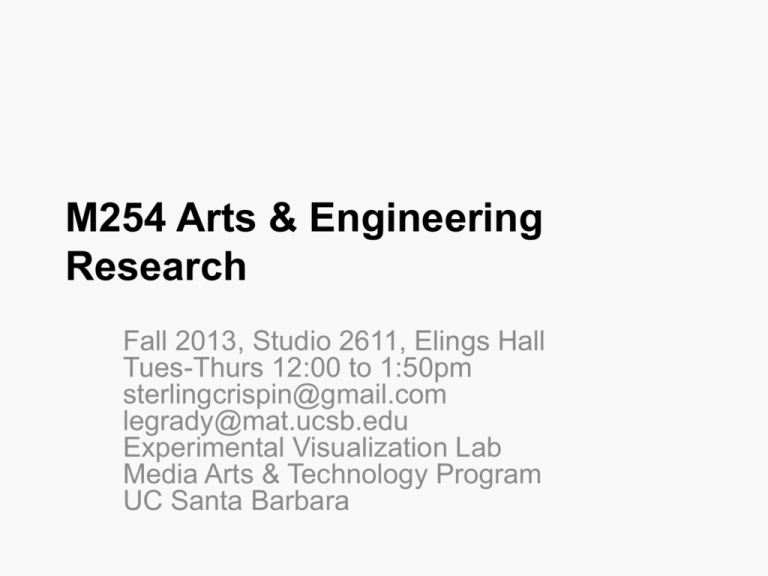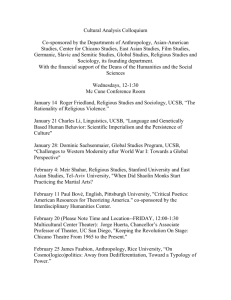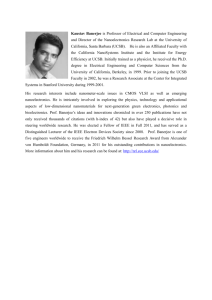Intro PPT
advertisement

M254 Arts & Engineering Research Fall 2013, Studio 2611, Elings Hall Tues-Thurs 12:00 to 1:50pm sterlingcrispin@gmail.com legrady@mat.ucsb.edu Experimental Visualization Lab Media Arts & Technology Program UC Santa Barbara M254 Study Plan & Goals What is Research? How does research take place? Articulate the methodologies and processes What are theoretical & applied directions? What are the intersections of arts and engineering/science? Research Definitions Any gathering of data for the advancement of knowledge Basic Research: Driven by interest to increase understanding about fundamental principles Applied Research: A form of systematic inquiry involving literature study, methodologies, with the goal of solving practical problems Scientific Research Information and theories about the properties of the world Hypothesis: A testable prediction Conceptual definition: Description of a concept Gathering Data: Selecting samples (with instruments) Analysis of Data: To draw conclusions Verification of Hypothesis Communication of Results Artistic Research Creative works are considered both the research and the object of research Usually practice based but some artists bring analytical methods (semantics, semiotics, etc.) Methodologies tend to be individually defined rather then discipline prescribed Value: To what degree does the artistic approach create meaning that could not have been addressed otherwise? Humanities Research Interpretation is determined by Context: Social, historical, cultural, political, etc. Argue that data is never neutral. Its meaning is always determined by interpretation Focus is on the process of interpretation Culture and ideology determine the meaning of data Generalities There is effort to capture phenomena Through collection of data Next step of analyzing the data leads to Discovery. How does that happen? How does one then represent results? Each discipline has specific conventions: papers, conferences, books, installations, visualizations, performance, etc. To what degree does discipline-specific conventions allow for and constrain expression? Aesthetic Considerations Science relies on methodology - to what degree does aesthetics have a role in decision-making? Aesthetics: Perception, the senses, what feels coherent, insightful, etc. Metaphor: Something is like something else. Nature does it better Indexicality: Points to something else Serendipity in Science: Case studies Course Goals To map out the process by which data collection leads to discovery To study the role of tools, technologies as means of discovery expressions To what degree is the representation a neutral process? What we will do in the course Each student may have a specific research agenda: Define the agenda Course focus is to define methodology of discovery and representation We will study examples of research through science lab visits and review of UCSB research activities as listed at: http://www.ucsb.edu/news-topics/ A presentation/short paper of conclusions of similarities/differences based on lab visits Schedule Wk1: Review of research definitions: What are various forms of research: science research, humanities research, and artistic research. Wk2, 3: How do scientists get from analysis of data to discovery? What is the methodology and what is the process by which that happens? Do artists proceed in a similar or different way? Wk4,5: What are the methods of representation? To what degree do Aesthetics play a role in the process of scientific representation? (rather then the look of it?) Wk 3 to 10 intermittent: We will visit labs, study how the UCSB news has synthesized research into a form that has broad understanding Wk 6, 7:Once discovery is achieved how is it represented, conveyed, etc. Whereas data to discovery is a process of transformation, representing knowledge involves translation. Wk 8,9,10:The course will complete with a student presentation on the topic of research, discovery, and representation, as a paper posted at the course website References The Nature of Technology, W. Brian Arthur (NYTimes review) Ignorance: How it Drives Science, Stuart Firestein, (NYTimes Review) Nature of Science UCSB News Topics Impact of your Work in the Course Results will impact on the following: A symposium (winter 2014) which will bring together experts in the fields of Arts, Engineering and Humanities research methodologies An exhibition of scientific research scheduled for 2016 for the UCSB Art Museum Questions to explore: Science is a procedural process so what are the methods by which data becomes discovery? What are the metrics for evaluation? To what degree does aesthetics have a role • a) in the discovery process and • b) in the experience of presenting the research? Contributions to the field:(from J.Gibson ECE) Define what you did and why was it worth it? What is the state-of-the art and where does your work fit in? What were the key decisions that you made and why did you make those choices? What are the results and how does your work compare with others in the field? How did the decisions that you made impact your results and performance? What future research should be pursued to build on your work? George Legrady Director, Experimental Visualization Lab Media Arts & Technology PhD program University of California, Santa Barbara http://vislab.ucsb.edu http://www.georgelegrady.com


